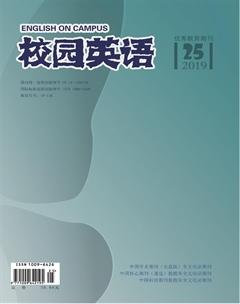An Analysis of the Anima in Jung’s Archetypes and the Collective Unconscious
【Abstract】The anima and animus are described in Carl Jungs Archetype and the Collective Unconscious as part of his theory of the collective unconscious. This article mainly focus on the analysis of the anima archetype and the detailed description of the psychological formation of the hero in Edgar Allen Poes Black Cat.
【Key words】Jung; Anima; Black Cat
【作者簡介】郜聿页(1994.12-),女,汉族,江苏人,上海师范大学硕土研究生,研究方向:英语语言文学。
1. The Analysis of Anima
The anima and animus are described in Carl Jungs The Archetypes and the Collective Unconscious as part of his theory of the collective unconscious. Jung described the animus as the unconscious masculine side of a woman, and the anima as the unconscious feminine side of a man, with each transcending the personal psyche.
In the unconscious of every man there is hidden a feminine personality, and in that of every woman a masculine personality. It is a well-known fact that sex is determined by a majority of male or female genes, as the case may be. But the minority of genes belonging to the other sex dose not simply disappear. A man therefore has in him a feminine side, an unconscious feminine figure——a fact of which he is generally quite unaware. I may take it as known that I have called this figure the “anima”, and its counterpart in a woman the “animus”. The archetype of “anima” and “animus” is the most controversial part of Jungs psychology, and also an important theory to explain androgynous personality.
2. The anima Archetype in Allan Poes Black Cat
The background of the short novel Black Cat is a daily family life, and the narrator was in a large environment with a feminine atmosphere. We can see that the female temperament of the narrator has been manifested since his childhood, “I have been noticed by others because of my gentleness and kindness since childhood.” This feminine temperament became more and more obvious in the process of taking care of the pets. “My favorite thing is to raise and touch pets.” Jung believes that when human beings are fetuses, there is no gender distinction, and the acquired life will shape human beings into men and women, but even so, people still retain some of the temperament of the opposite sex properly. Therefore, when the “anima” is obvious, his female characteristics would become obvious, too.
According to Jungs theory, when “Anima” is obvious, men become feminized, indulging in fantasy, unrealistic, extremely sensitive, jealous, hesitant, timid and so on. These characteristics are reflected in the narrator, especially jealousy.
The narrators wife spoiled the second cat, and the cat “soon got the special love from my wife”, “I found that it also had one eye missing, just like Brutu, but this situation made my wife more in love with it.” At this time, the wife seemed to play the role of “Anima” which he was trying to suppress, and he was jealous of his wife, and perhaps this kind of jealousy has always been there. Inevitably, in order to maintain his masculinity, the narrator began his more brutal and extreme violence. His wife still had “deep warmth”, which were his original characteristics, “has offered me the simplest purity and happiness, his wife completed his inner “anima” role, and he could only give up the inner “anima” in order to pursue the extreme male temperament.
The narrator, who was jealous of his wife, became more and more angry and committed excessive behavior --- killing his wife. The violence against the second cat ended with the murder of his wife. When the police came to investigate, the narrator showed extreme masculinity. However, the masculine mask did not last long, and the cat began to scream. When the police found the cats body, the narrator was stunned. I almost fainted and staggered to the wall. These performances deepened the narrators feminine temperament. Although the narrator tried hard to portray himself as a very masculine man, in the end he only showed feminine weakness. We can infer that, whether violence or murder, is only a manifestation of the narrators masculinity, and the “anima” in his personality has always been evident.
3. Conclusion
By analyzing the the anima in Carl Jungs Archetype and the Collective Unconscious, and an application of analyzing the anima in an literature work, the anima is more clear and meaningful for psychological study.
References:
[1]Jung.Creative Writers and Daydreaming. Western Literary Theories: A Bilingual Course to Develop Critical Thinking[M]. Lu Min ed. Wuhan: Wuhan University Press,2018,8:147-166.

